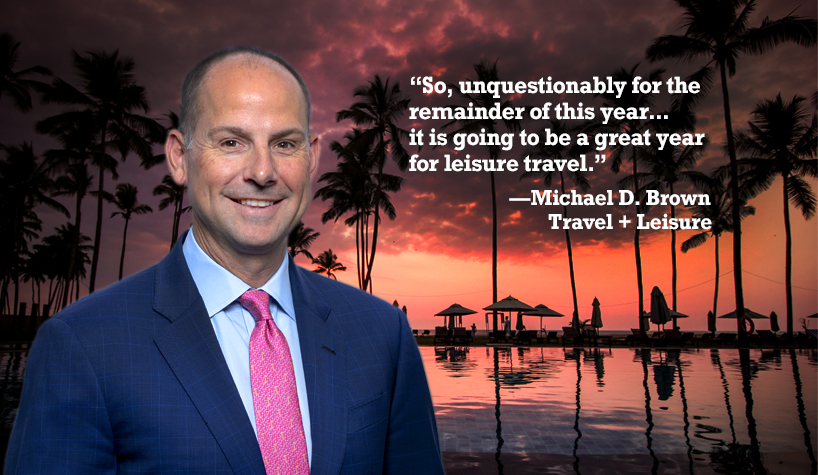With his company’s Q1 results as an indication, Michael D. Brown, president/CEO, Travel + Leisure Co., believes that the leisure travel segment is moving strongly on its road to recovery.
“We did our Q4 call at the end of February, and at that point, we felt that recovery was coming, but we just didn’t know when,” said Brown, who took on his current position when Wyndham Destinations acquired the Travel + Leisure brand in January. “It was only about 10 days later where it was as if a light switch was turned on and consumers said, ‘I am now comfortable to travel,’ because the booking trends dramatically improved the last three weeks of March. As a result, we finished the quarter extremely strong, not only from a sales standpoint but from an underlying metrics standpoint that really points, time and time again, to a recovering consumer.”
The recovery that experts have been predicting is here. “If we would have spoken 60 days ago, I would have been prognosticating, but what we have seen in March and what we have seen continue with the same level of enthusiasm in April says, first of all, the pent-up demand is showing through,” he said. “It is being realized. We are a 100% leisure business, so we are at the forefront of the benefit of the recovery.”
The recovery is evidenced by the fact that bookings for the second half of the year are higher than they were in 2019, which was a peak year for the company. “So, unquestionably for the remainder of this year, unless something happens, which what that something is, I can’t imagine, it is going to be a great year for leisure travel,” said Brown. “The change we have seen in the last 30 days is that we are seeing a much stronger willingness to get on an airplane in order to enjoy their leisure travel.”
He pointed to bookings in Hawaii as an example of the increase: “In April, our bookings for the remainder of this year for Hawaii is up 33%. In January and February, they were down 40% compared to the same two months in ’19. A flip from minus-40 to plus-33 just shows that not only do people want to travel, but they feel comfortable enough to get on a plane to go somewhere.”
Brown said that the company made a number of strategic moves prior to the pandemic—and during it—to prepare for a possible downturn. “It had been a 10-year cycle of positive economic growth and we were expecting a recession, not near as deep as COVID-19 gave us, but we saw the opportunity that on a post-pandemic environment that we wanted to change a few elements of our business,” he said.
That change included a shift in the company’s marketing approach to elevate the credit quality of its guest. “[We] made a strategic shift to go after what we call quality earnings—higher margins requiring less to get back to the same profitability post-pandemic,” said Brown. “That meant that we had to make a number of decisions. [First], we changed our marketing standards and increased the credit quality. Secondly is we reduced our cost basis. We estimate that will have taken out $60 million of permanent costs.”
The biggest move was the acquisition of the Travel + Leisure brand this January, to expand beyond the vacation ownership market that Wyndham Destinations is known for. “We made a very important acquisition of the Travel + Leisure brand at the beginning of this year to begin our pivot, not away from, but in addition to the vacation ownership industry into the broader leisure travel market,” he said.
The acquisition opens up a new market for the company. “If you were to size the U.S. households that really meet that qualification they were looking for, it is about 100 million households, and timeshare is only 10% of that,” he said. “We wanted to offer a product that allowed us to be a broader travel offering to the non-timeshare owner. We felt the Travel + Leisure name with its iconic history and credibility in the marketplace and 36 million followers was, through the acquisition, the right place to offer such a product.”
While the details are still being finalized, Brown revealed to Hotel Business that, later this year, the company will by offering a travel subscription club under the Travel + Leisure name. He likened it to a HomeFresh Meal delivery service or Netflix subscription, “where you are getting offered content, convenience and great value without the long-term commitment.”
For the monthly fee, which Brown said may be around $10, subscribers will receive access to a variety of travel benefits, much of which will be tied directly to exclusive content in the Travel + Leisure magazine. “If Travel + Leisure is writing about these destinations and locations, they are probably destinations and locations and experiences that the broad consumer will want to experience,” he said.
The editorial will be independent. “We do not affect what they write, where they write, who they write,” said Brown. “They come up with their own additions and plan for the year. We will link into them and then approach the companies that they write about and offer to include them as part of the Travel + Leisure subscription club. In a way, it is a way for them to not only get the benefit of awareness but also drive the commercial side of the business.”

